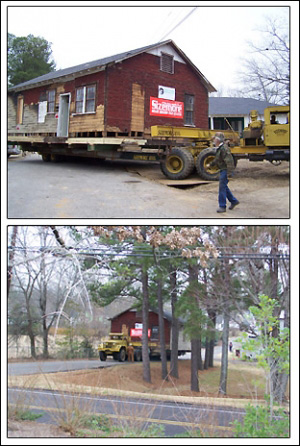Two weeks ago, the Elvis Presley Memorial Foundation announced the newest venue at the Birthplace and Park will be the church where Elvis learned the basic chords he needed to begin the trek that ultimately made him the “King of Rock and Roll.” The original structural of the First Assembly of God church in East Tupelo has now been moved to be fully restored as it was when Elvis and his family worshiped there.
“The church will be within 100 feet of the existing memorial chapel built by fans’ donations at the Birthplace,” said Henry Dodge, Chairman of the Elvis Presley Memorial Foundation. “This will present the full life cycle of the gospel music of Elvis, from the roots learned as a boy in the historical original church to the Birthplace memorial chapel where the contemporary gospel music of Elvis is constantly played. This will be the only place in the world where fans can have that experience,” Dodge added. “The First Assembly of God Church in East Tupelo was at the center of the Presley family’s life and provided the social structure as well as entertainment on which the family thrived. Young Elvis regularly sang in church, as did many of the members, but according to his minister, Brother Frank Smith, Elvis was fascinated with music and the prospect of learning to play the guitar. Brother Frank taught Elvis how to make a D chord, an A chord and an E chord…all he needed to play “Ole Shep,” Guyton said.
Church, and especially the music of the church, was the motivation for Elvis to become a performer. After the Presleys moved to Memphis in 1948, Elvis regularly went to the all night gospel sings at Ellis Auditorium, near his home in Lauderdale Courts. His burning ambition was to become a member of a gospel quartet. He never realized his dream of becoming a member of the Statesmen or the Blackwood Brothers. He had other worlds to conquer. Throughout the rest of his life, Elvis recorded many of the beloved songs of his youth, the emotional and uplifting music of the church.
The actual building where the Presley family attended services is itself an artifact. Through original photographs of this church and other churches of this area, we will restore the inside and outside of the building to the look of 1940.
The Assembly of God Pentecostal church services of this time period will be described and featured in a multi-media presentation. The plain, humble structure will greatly contrast with the lively and intense nature of the sermons and the music.
Small groups of visitors will be admitted to the church, the optimum number will be 10 to 15 people at a time. A docent will invite them inside. Once visitors take a seat in the center of the church, the docent will turn a key switch that activates the first projector. The entire presentation is about 10 minutes in length. During heavy traffic times the maximum time between tours will be 15 minutes.
The presentation will introduce visitors to aspects of a “neighborhood church” in Elvis’ day and explain the Assembly of God religion. “We plan to film an actual church service in the renovated church using several cameras at different locations,” Guyton said.
A four-minute introductory segment will be shown on the center wall located behind the pulpit. Included will be an overview of the Pentecostal religion, the Assembly of God denomination, and southern Christian churches of the 1940’s.
“We have been working on this quite some time,” Guyton said. “We appreciate the cooperation of the Stanford family and the valuable assistance of real estate professional Tina O’Quinn in helping us acquire the structure. Additionally, Elvis’ boyhood friend Guy Harris was instrumental in helping us locate the structure.
“We have made many significant changes at the Birthplace and park over the past several years as we continue to find exciting new ways to continue to tell the story of the innocence of Elvis,” Guyton said.
The project is being funded by the Elvis Presley Memorial Foundation from ticket sales and gift shop purchases of fans, and by a $40,000 donation from the Carpenter Foundation.
Church On The Move
February 03, 2008 | Other